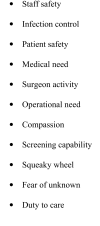SARS and hospital priority setting: a qualitative case study and evaluation
- PMID: 15606924
- PMCID: PMC544195
- DOI: 10.1186/1472-6963-4-36
SARS and hospital priority setting: a qualitative case study and evaluation
Abstract
Background: Priority setting is one of the most difficult issues facing hospitals because of funding restrictions and changing patient need. A deadly communicable disease outbreak, such as the Severe Acute Respiratory Syndrome (SARS) in Toronto in 2003, amplifies the difficulties of hospital priority setting. The purpose of this study is to describe and evaluate priority setting in a hospital in response to SARS using the ethical framework 'accountability for reasonableness'.
Methods: This study was conducted at a large tertiary hospital in Toronto, Canada. There were two data sources: 1) over 200 key documents (e.g. emails, bulletins), and 2) 35 interviews with key informants. Analysis used a modified thematic technique in three phases: open coding, axial coding, and evaluation.
Results: Participants described the types of priority setting decisions, the decision making process and the reasoning used. Although the hospital leadership made an effort to meet the conditions of 'accountability for reasonableness', they acknowledged that the decision making was not ideal. We described good practices and opportunities for improvement.
Conclusions: 'Accountability for reasonableness' is a framework that can be used to guide fair priority setting in health care organizations, such as hospitals. In the midst of a crisis such as SARS where guidance is incomplete, consequences uncertain, and information constantly changing, where hour-by-hour decisions involve life and death, fairness is more important rather than less.
Figures
References
-
- Health Canada Learning From SARS: Renewal of Public Health in Canada. 2003. http://www.hc-sc.gc.ca/english/protection/warnings/sars/learning.html
-
- Daniels N, Sabin J. Setting Limits Fairly: can we learn to share medical resources. Oxford, UK: Oxford University Press; 2002.
-
- Ham C, McIver S. Contested Decisions: Priority setting in the NHS. London, UK: King's Fund Publishing; 2000.
-
- Ham C, Roberts G, eds . Reasonable Rationing: International Experience of Priority Setting in Health Care. Maidenhead, UK, Open University Press; 2003.
Publication types
MeSH terms
LinkOut - more resources
Full Text Sources
Medical
Miscellaneous


